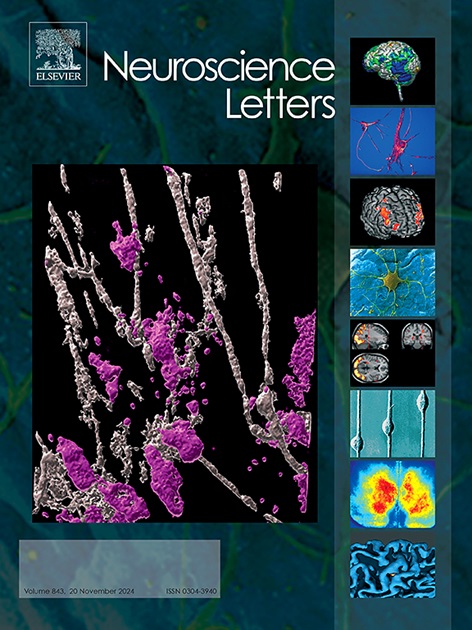经颅磁刺激诱发的MEPs在会话内、会话内和会话间的可靠性:峰对峰振幅与曲线下面积的关系
IF 2
4区 医学
Q3 NEUROSCIENCES
引用次数: 0
摘要
皮质脊髓兴奋性(CSE)是皮质脊髓和脑-肌肉通路的反应性,通过经颅磁刺激(TMS)使用运动诱发电位(MEPs)进行评估。它为运动控制、神经可塑性和神经系统疾病提供了至关重要的见解。在临床和研究环境中使用经颅磁刺激诱发的MEPs取决于其内部和间歇的可靠性。本研究旨在评估两种量化MEP大小的不同方法的可靠性:峰间振幅(PPA)和曲线下面积(AUC)。在这些量化方法之间建立一致对于确保由同一评估人员进行一致的测量是至关重要的,特别是在会议内部和会议之间进行的前测试和后测试设计中。12名健康的参与者自愿参加了这项研究。每个参与者的30个mep被记录下来,使用单脉冲TMS设置为静息运动阈值(RMT)的120%,持续两个疗程。第一阶段包括两个测试(T1和T2),两组之间有20分钟的休息时间。第二次会议包括一组测试(T3)。采用单因素方差分析和类内相关系数(ICC)评估MEP振幅和AUC的重测信度。单因素方差分析显示,时间对MEP振幅或AUC值没有显著影响,表明会话之间的一致性。ICC显示了PPA在会话内和会话间的显著可靠性。然而,AUC值与T1-T3之间的相关性较弱。综上所述,本研究表明PPA比AUC更可靠地用于评估CSE的变化。未来的研究应探讨AUC方法在临床环境或研究方案中的可靠性。本文章由计算机程序翻译,如有差异,请以英文原文为准。
Intra-rater within- and between-session reliability of TMS-induced MEPs: peak-to-peak amplitude versus area under the curve
Corticospinal excitability (CSE) is the responsiveness of the corticospinal and brain-to-muscle pathway, assessed using motor-evoked potentials (MEPs) via transcranial magnetic stimulation (TMS). It provides crucial insight into motor control, neuroplasticity, and neurological conditions. The use of TMS-induced MEPs in clinical and research contexts is contingent upon their intra- and intersession reliability. This study specifically aimed to assess the reliability of two distinct methods for quantifying MEP size: peak-to-peak amplitude (PPA) and the area under the curve (AUC). Establishing the agreement between these quantification methods is critical for ensuring consistent measurements by the same assessor, especially in pre- and post-test designs conducted within and between sessions. Twelve healthy participants volunteered for this study. Thirty MEPs were recorded from each participant using a single-pulse TMS set at 120% of the resting motor threshold (RMT) over two sessions. The first session consisted of two tests (T1 and T2) with a 20-minute rest interval between sets. The second session included one set of tests (T3). Test-retest reliability of MEP amplitude and AUC were assessed using one-way ANOVA and Intraclass Correlation Coefficient (ICC). A one-way ANOVA revealed no significant effect of time on MEP amplitude or AUC value, indicating agreement between sessions. The ICC demonstrated significant intra- and inter-session reliability for PPA. However, correlations between T1-T3 were weak for AUC values. In conclusion, this study suggests that PPA a more reliable measurement than AUC for assessing changes in CSE. Future investigations should explore the reliability of the AUC method in clinical settings or research protocols.
求助全文
通过发布文献求助,成功后即可免费获取论文全文。
去求助
来源期刊

Neuroscience Letters
医学-神经科学
CiteScore
5.20
自引率
0.00%
发文量
408
审稿时长
50 days
期刊介绍:
Neuroscience Letters is devoted to the rapid publication of short, high-quality papers of interest to the broad community of neuroscientists. Only papers which will make a significant addition to the literature in the field will be published. Papers in all areas of neuroscience - molecular, cellular, developmental, systems, behavioral and cognitive, as well as computational - will be considered for publication. Submission of laboratory investigations that shed light on disease mechanisms is encouraged. Special Issues, edited by Guest Editors to cover new and rapidly-moving areas, will include invited mini-reviews. Occasional mini-reviews in especially timely areas will be considered for publication, without invitation, outside of Special Issues; these un-solicited mini-reviews can be submitted without invitation but must be of very high quality. Clinical studies will also be published if they provide new information about organization or actions of the nervous system, or provide new insights into the neurobiology of disease. NSL does not publish case reports.
 求助内容:
求助内容: 应助结果提醒方式:
应助结果提醒方式:


